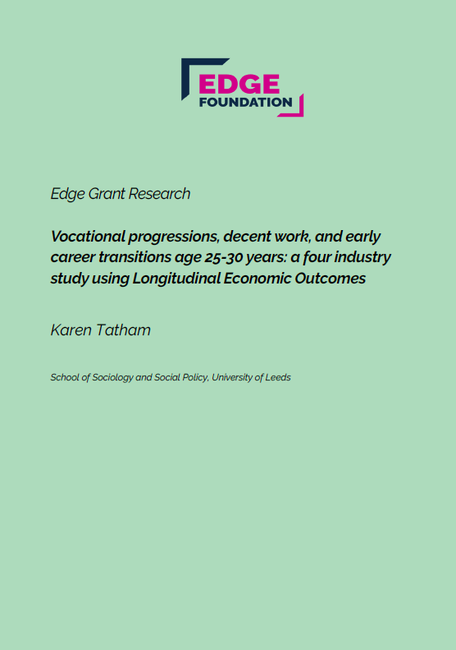Karen Tatham - Vocational progressions, decent work, and early career transitions age 25-30 years: a four industry study using Longitudinal Economic Outcomes
English vocational qualifications form a fragmented and complex system. Vocational qualifications are undergoing significant reform with the defunding of large numbers of Level 2 and 3 qualifications, and the strengthening of Higher Technical Qualifications (HTQs) and degree apprenticeships pathways. Typically, higher levels of qualification lead to higher earnings, but some vocational pathways, particularly at Level 2 and 3 are characterised by long-standing concerns over labour market polarisation and poor job outcomes. There is limited progression beyond Level 3 qualifications for large numbers of young workers, where young people holding vocational qualifications are under-represented in higher education.
Despite these well-known patterns of inequality, there is remarkably little vocational Longitudinal Economic Outcomes (LEO), and pathway data collected, against extensive, annual empirical longitudinal datasets and detailed studies of graduate outcomes across industries. The development of employer-led qualification and skills systems means it becomes important to better understand how young workers are distributed into the labour market. The following analysis contributes in part to this gap.
This study draws from secondary quantitative analysis of the “Career Pathways: Post 16 qualifications held by employees” Longitudinal Economics Outcomes (LEO) dataset (DfE, 2022a). The dataset allows an understanding of the qualification patterns and median wage returns for young workers aged 25-30 years in 2018-19. This study focuses on the four largest sectors by employment for those aged 25-30 years in the English labour market. Between them, these four sectors employ over 50% of young adult workers aged 25-30 years: Wholesale and Retail (16.8%); Health and Social Work (13.0%); Education (9.7%) and Professional Services (9.6%) (DfE, 2022a). Building on initial analysis by the DfE (2022), further secondary quantitative analysis was carried out as part of this study which disaggregated industry, and sub-sector level data by number of employees, highest qualification held and median earnings.

